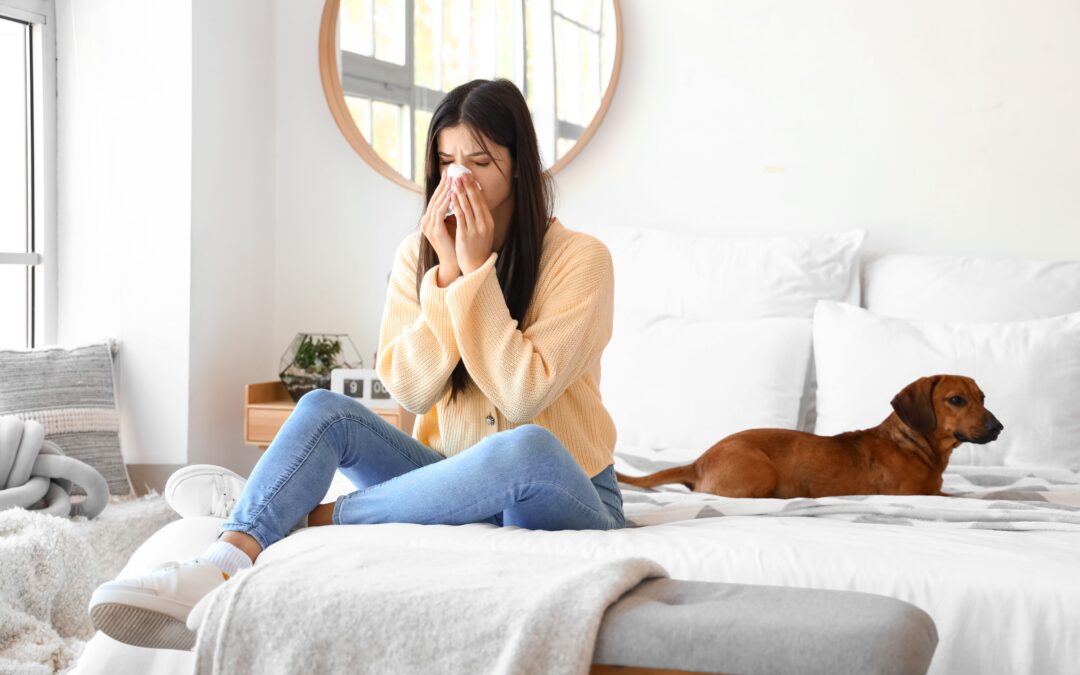Indoor allergens are a common problem for many people, causing symptoms like sneezing, coughing, and itchy eyes. Dust mites, pet dander, mold, and pollen are some indoor allergens that can trigger discomfort inside your home. If you’re sensitive to these allergens, it can make daily living difficult. Fortunately, there are simple strategies you can adopt to reduce indoor allergens and improve the air quality of your home.
In this blog, we’ll discuss effective tips for reducing indoor allergens and creating a healthier living space for you and your family.
1. Control Humidity to Prevent Common Indoor Allergens
High humidity levels provide the perfect environment for the growth of indoor allergens such as mold and dust mites. These microscopic pests thrive in damp conditions and can cause significant allergy symptoms. Aim to keep your home’s humidity below 50% to reduce moisture. Using a dehumidifier in areas like basements and bathrooms will help prevent mold growth, one of the most notorious indoor allergens.
Consider using a hygrometer to monitor your indoor humidity levels. Keeping it in check will reduce many indoor allergens in your home.
2. Regular Cleaning to Minimize Indoor Allergens
One of the easiest ways to combat indoor allergens is through regular cleaning. Dust, pet dander, and pollen can accumulate quickly on furniture, carpets, and other surfaces. Vacuuming at least once a week with a HEPA filter-equipped vacuum cleaner can help trap these allergens. Additionally, wiping down surfaces, cleaning air vents, and dusting bookshelves will reduce the amount of indoor allergens in your home.
Remember to wash your bedding weekly in hot water to kill dust mites, one of the most common indoor allergens. Regularly washing pillows and blankets will also help minimize exposure.
3. Use Air Purifiers to Filter Indoor Allergens
Air purifiers are an excellent tool for reducing indoor allergens in your home. A HEPA-certified air purifier can filter small particles like dust, pet dander, pollen, and even smoke. Placing air purifiers in bedrooms, living rooms, or other high-traffic areas will help ensure the air is free from these harmful allergens.
Using a high-quality air purifier can make a noticeable difference in indoor air quality, especially for households with pets or high levels of dust and indoor allergens.
4. Pet Care: Reducing Pet-Related Indoor Allergens
Pet dander is a significant source of indoor allergens, and it can be challenging to avoid if you have pets. While you may not be able to completely eliminate pet dander from your home, there are steps you can take to minimize its impact. Regular grooming and bathing of pets help reduce the dander they shed. Also, wash your pet’s bedding frequently to reduce indoor allergens that may accumulate there.
Keep pets out of bedrooms or other spaces where you spend a lot of time, as indoor allergens can often be most concentrated in these areas.
5. Declutter to Limit Dust and Indoor Allergens
Clutter can trap dust and make maintaining a clean and allergy-friendly environment harder. To reduce indoor allergens, consider minimizing the number of items that collect dust, such as books, magazines, and excessive decorations. A clean and minimalist space will help make it easier to dust and clean, preventing the buildup of indoor allergens on surfaces.
6. Invest in Allergen-Proof Bedding
Dust mites are one of the leading causes of indoor allergens in the home, particularly in bedding. Invest in allergen-proof covers for your pillows, mattresses, and comforters to combat this. These covers create a barrier preventing dust mites from settling in, reducing exposure to these irritating indoor allergens.
Pro Tip: Opt for synthetic or hypoallergenic bedding materials rather than down feathers, which are more likely to attract dust mites and indoor allergens.
7. Ensure Proper Ventilation to Avoid Indoor Allergens
Proper ventilation is essential for reducing indoor allergens and improving indoor air quality. Open windows when the weather permits to allow fresh air to circulate, helping to remove pollutants and allergens inside your home. If using air conditioning or heating systems, change the filters regularly to keep indoor allergens from circulating.
Install exhaust fans in bathrooms and kitchens to help remove excess moisture, a common contributor to indoor allergens like mold.
8. Know When to Seek Professional Help for Persistent Indoor Allergens
Even after following all these tips, some people still struggle with indoor allergens. If you’ve done everything you can but still experience symptoms, it might be time to seek professional help. At McGovern Allergy and Asthma Clinic, we specialize in diagnosing and treating allergies, asthma, and other respiratory issues. Our team can help identify the source of your indoor allergens and recommend the best treatment options.
Conclusion
Indoor allergens don’t have to control your life. You can reduce them by following simple steps—like controlling humidity, cleaning regularly, and using air purifiers—and create a more comfortable living space. Whether it’s minimizing pet dander, using allergen-proof bedding, or ensuring proper ventilation, every small change helps in your battle against indoor allergens.
If your allergy symptoms persist despite your best efforts, don’t hesitate to contact McGovern Allergy and Asthma Clinic for personalized treatment options and advice. Together, we can help you breathe easier and live a more comfortable, allergy-free life.

